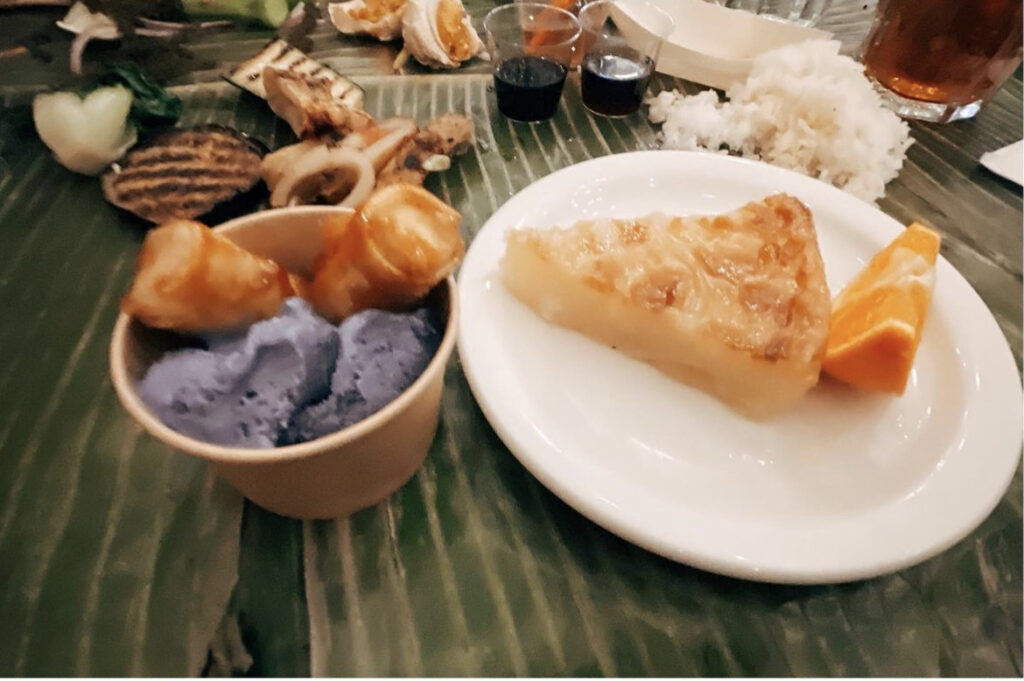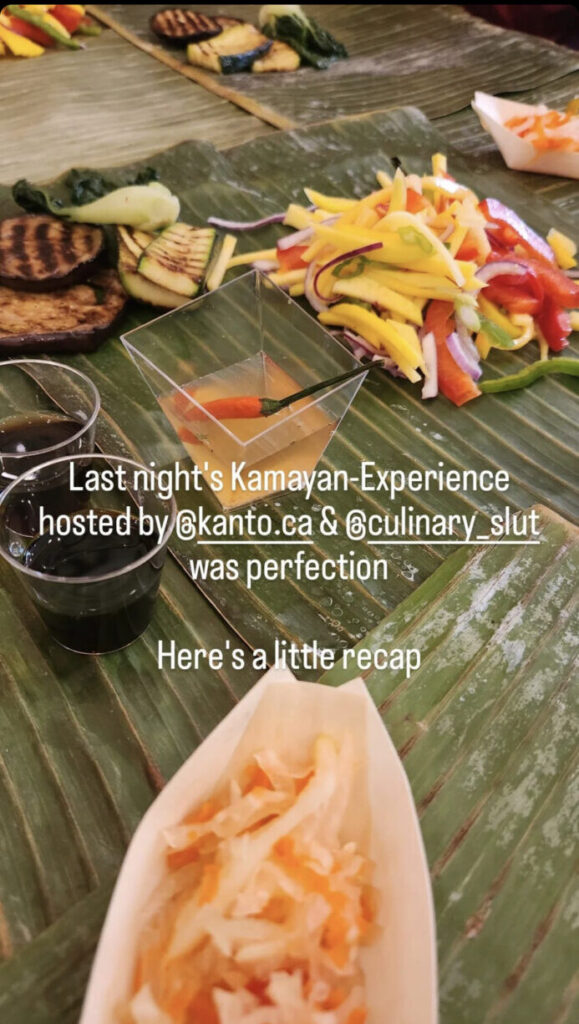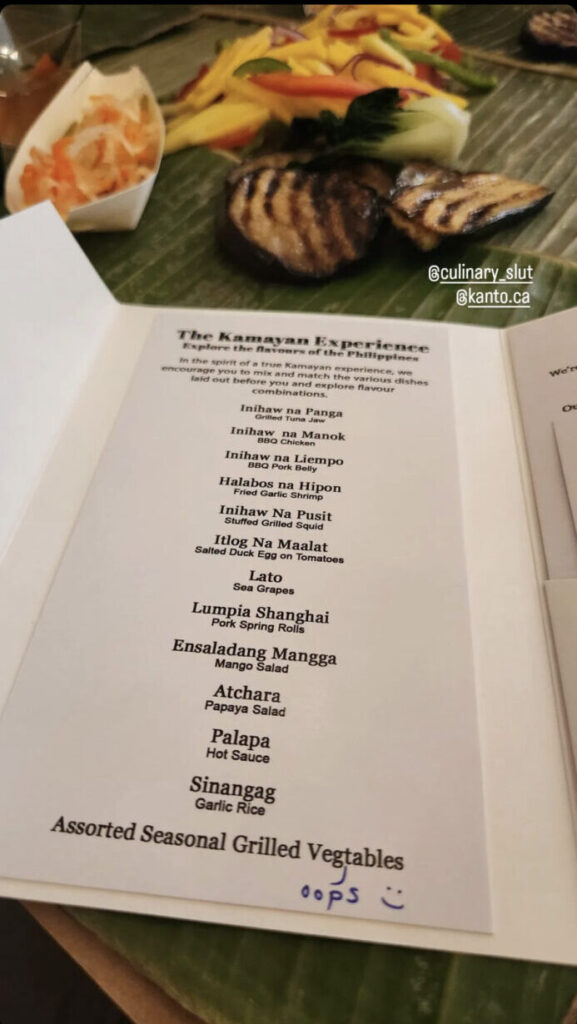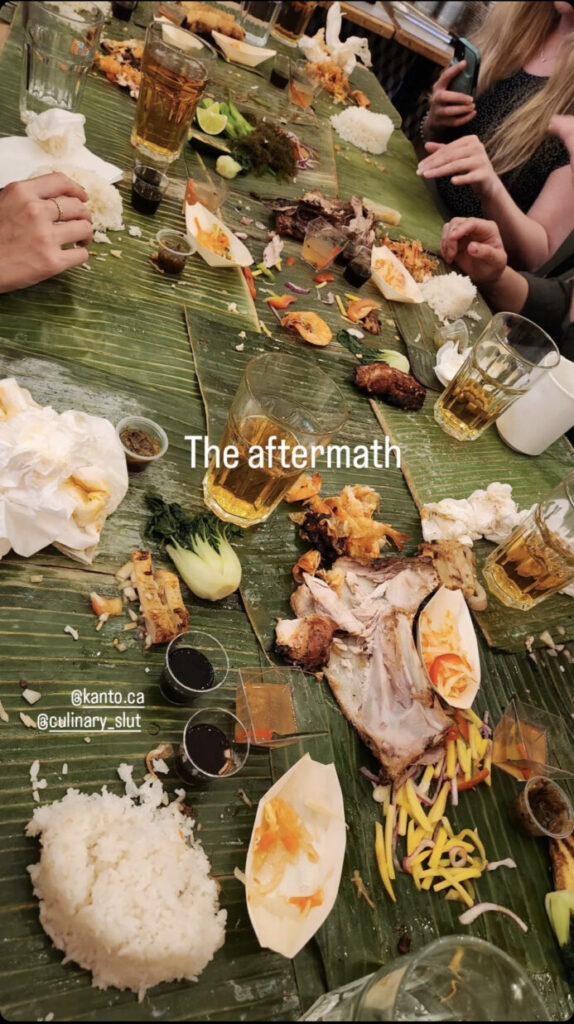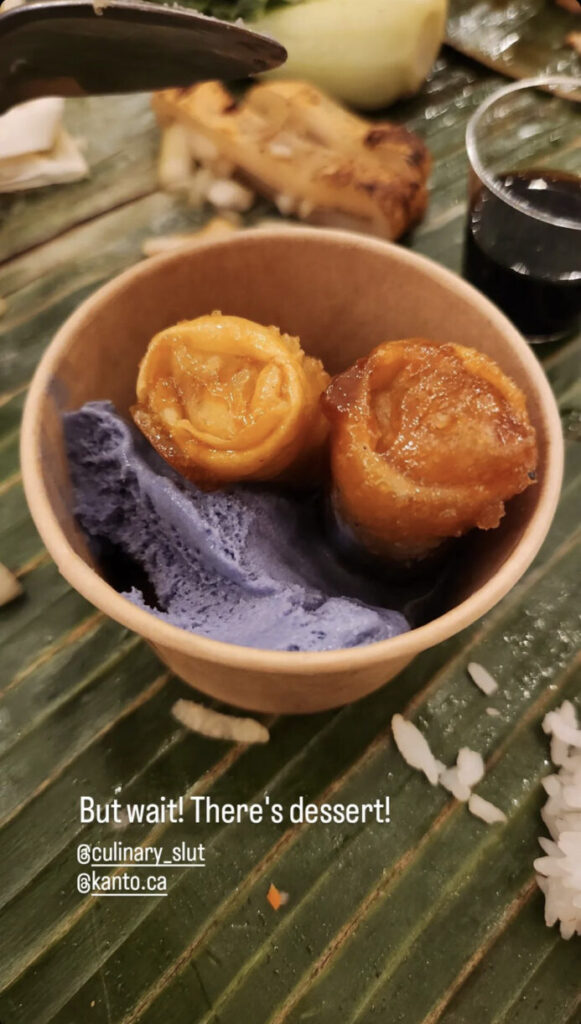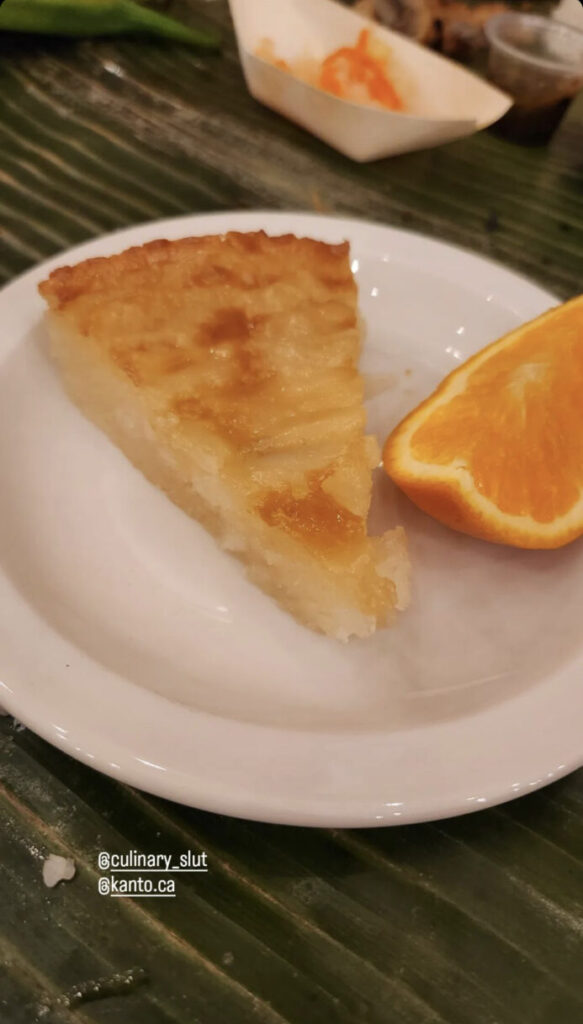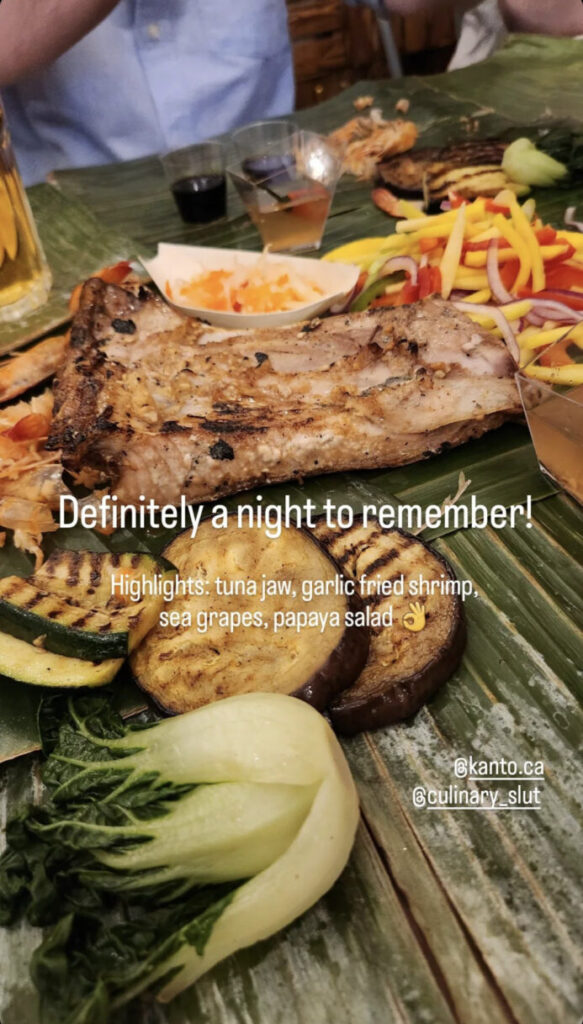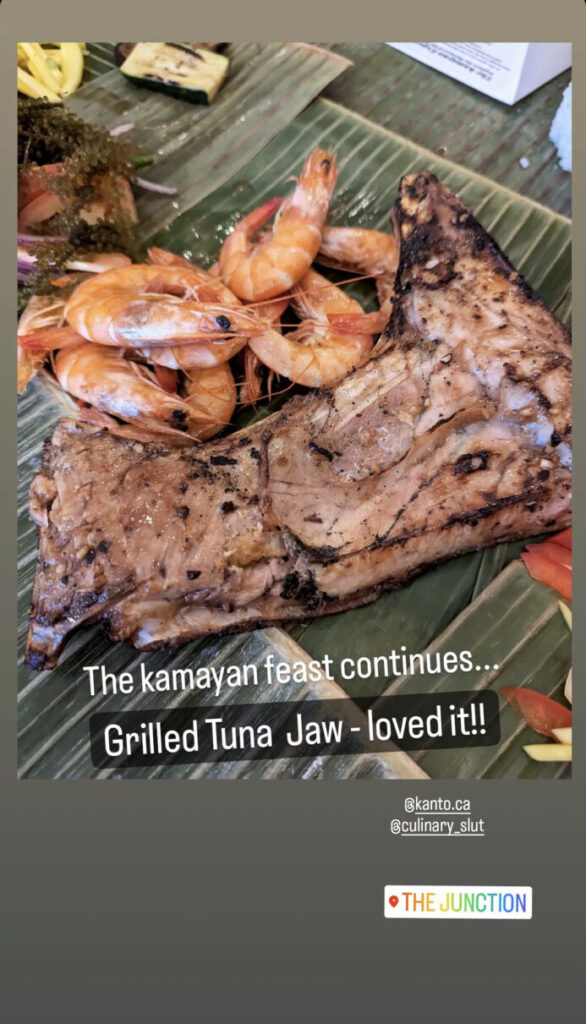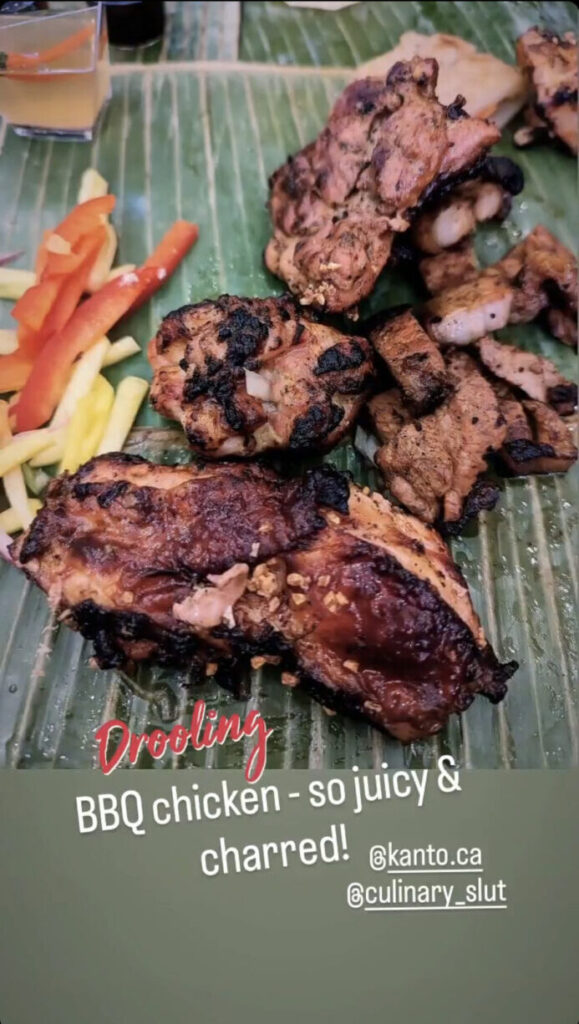The Kamayan Experience
Explore the flavours of the Philippines
We are so excited to share with you an exciting twist on a traditional Filipino classic. Diona – Chef and Creator of the first Filipino street food in Toronto – will be our host for a Kamayan Experience with a special “beach food” menu. The traditional style will include ingredients rarely available in Toronto. Among other delicious offerings, we’re excited that Diona will be serving tuna jaw (the taste and texture have to be experienced to be believed) and sea grapes imported directly from the Phillipines. This delicacy is really something special and is rarely seen outside the Phillipines.
Filipino cuisine is wonderfully varied, which can make it a bit confusing to describe. There are dishes of Spanish origin (embutido); Chinese origin (pancit) and indigenous creations (sinigang).
Doreen Fernandez, noted Filipino writer, teacher, cultural historian, food critic and scholar once wrote: “The reason for this confusion,” Fernandez says, “is that Philippine cuisine, dynamic as any live and growing phase of culture, has changed through history, absorbing influences, indigenising, adjusting to new technology and tastes, and thus evolving.”
Add to this that the Philipines has over 2,000 populated islands.
“Filipinos’ have a knack for combining flavours and making the most of any and all ingredients at their disposal. What results is unpretentious, no-frills food that’s simply delicious.

The details
- Gluten-Free Menu
- May 10, 2023
- 7:00 PM
- 2986 Dundas St. W. Toronto
- $115.00 (with HST and Eventbrite Fees $139.91)
Gratuity: Please note that our guests are not expected to provide a gratuity to staff at the end of the event.
Refund Policiy: Ticket sales end one week before the event so the restaurant can order all the specialty ingredients for the number of people attending. As a result, we do not issue refunds.
Allergies and Intolerances
This Menu Includes:
Meat, Pork, Dairy, Eggs, Crustaceans/Fish, Soybeans, Sesame
This Menu Is Gluten-Free
Kamayan Style Dining
Get Ready To Get Traditional:
Kamay is the Tagalog word for “hand”. Kamayan simply means “eating with the hands”. This is a traditional way to enjoy a communal feast in the Philippines. A copious amount of food is served on banana leaves and eaten without utensils. (Sidebar: While utensils had always been used for serving food, they were not used for eating until colonization. During the American colonization (1898–1946) the use of spoons and forks was aggressively promoted).
At a Kamayan feast, diners eat with one hand only, keeping their other hand clean for using serving utensils or holding their drink. This is a traditional, informal way of eating that encourages conversation and laughter throughout the meal – trust us, it’s much fun!
And don’t worry, our hosts will teach you how to eat rice with your fingers and there will be plenty of wet naps!
Learn More About Our Host
One of the coolest things about Off the Menu is the chance to meet the people “behind the plate”.
We’re very excited that Diona Joyce – aka: Tita Flips – is hosting our first Toronto Off the Menu evening. Diona is one of the most passionate restaurateurs we’ve met, and she has a wealth of knowledge about the history and origins of Filipino food from every region of that diverse country.
You’ll have the opportunity to meet Diona and to hear from her some of the stories behind the special Kamayan food that she and her team have prepared for you. You’ll have the opportunity to ask her questions, and some people may be lucky enough to get her one-on-one instruction on how to eat her dishes using only your hand!
We’ve had the pleasure of getting to know this amazing woman over the past year or so and we can say for certain that you’re in for a real treat. If you want to get to know her better in advance of the event, check out the video.
We also encourage you to explore Kanto’s excellent Instragram account and, if you like it, show them some love with likes, shares and a follow!
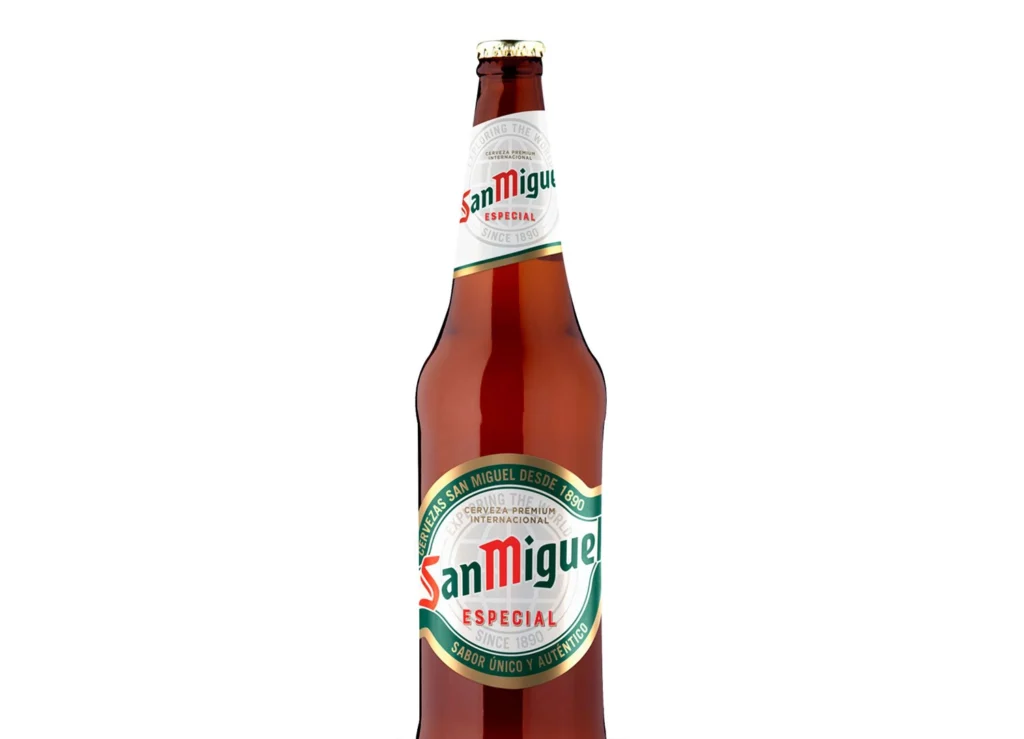
Drinks
Each guest will be offered one bottle of San Miguel Beer, the most popular choice in the Philippines. It is noted for the slight hoppy note with a distinct character. It has a well-balanced medium body and is smooth on the palate with a pleasant clean finish. Any additional drinks – alcohol, bottled water or soda – will have to be paid for at the end of your meal.
Tea is available to you all night as part of your meal.
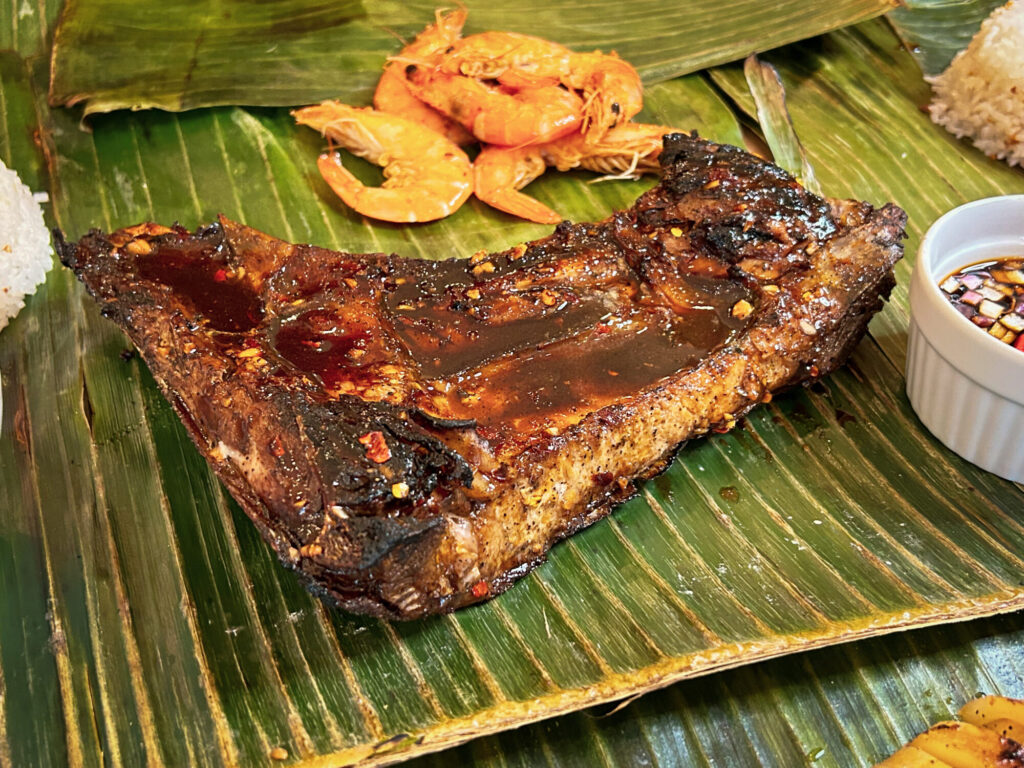
Inihaw na Panga
Grilled Tuna Jaw.
Marinated in soy, sugar, calamansi (a citrus fruit central to Filipino cuisine). This dish is the star of the night and will pair perfectly with the beer. It’s so rich, firm and meaty that we immediately commented that it could be mistaken for pork. Tuna Jaw is infused with collagen, making it very juicy, tender and flavourful. In the Philippines this is one of the most sought after parts of the tuna-fish, but you may never see it in markets here. This dish will knock your socks off.
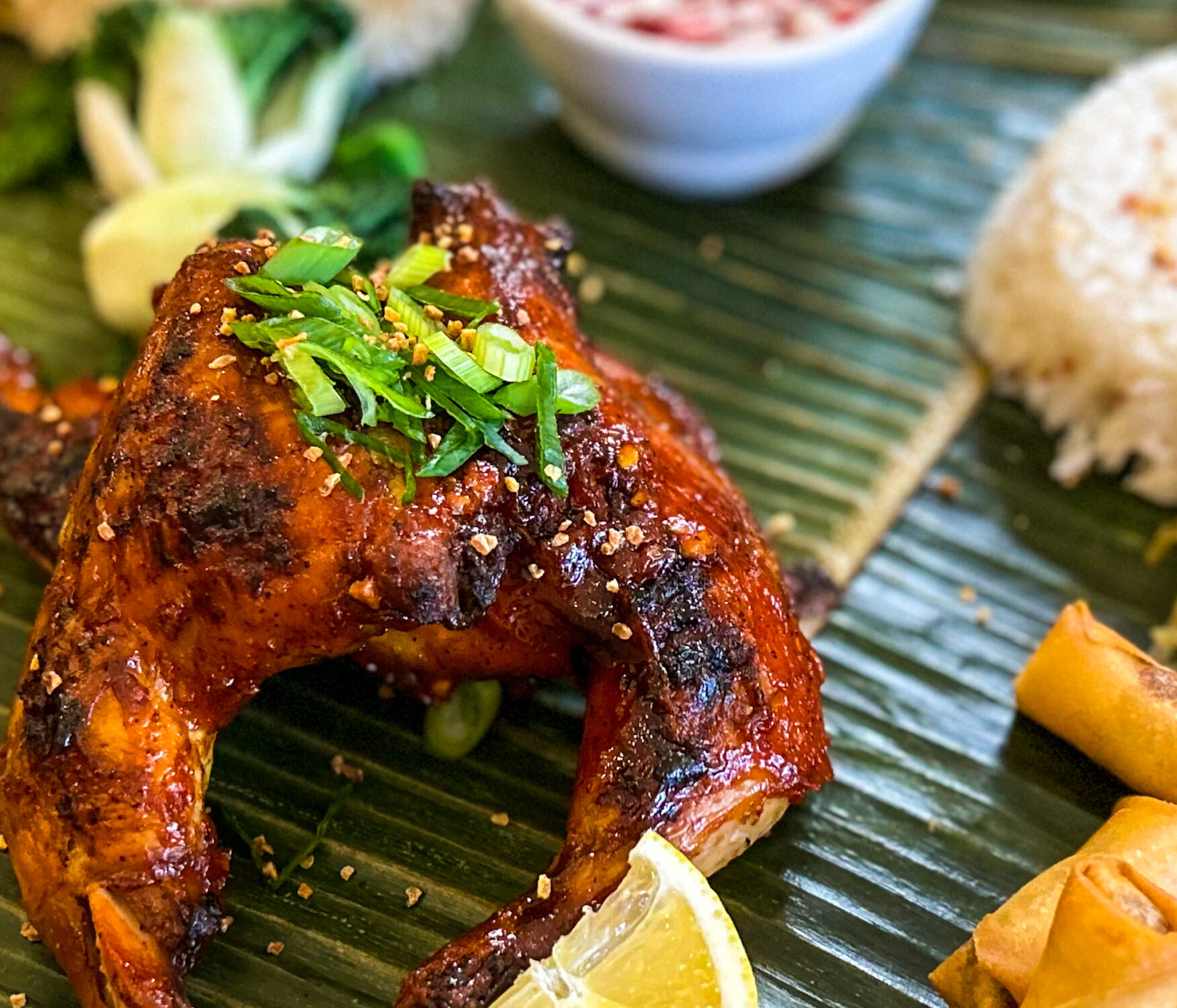
Inihaw na Manok
BBQ Chicken. No beach feast is complete without this! This sour, sweet, and salty chicken is cooked with lots of garlic. The marinade includes soy sauce and banana ketchup. There’s no tomato in this particular condiment, it’s made using bananas, spices and vinegar. According to Wikipedia (the fount of all knowledge!), banana ketchup was invented in the Philippines during WWII because there was a wartime shortage of tomatoes.
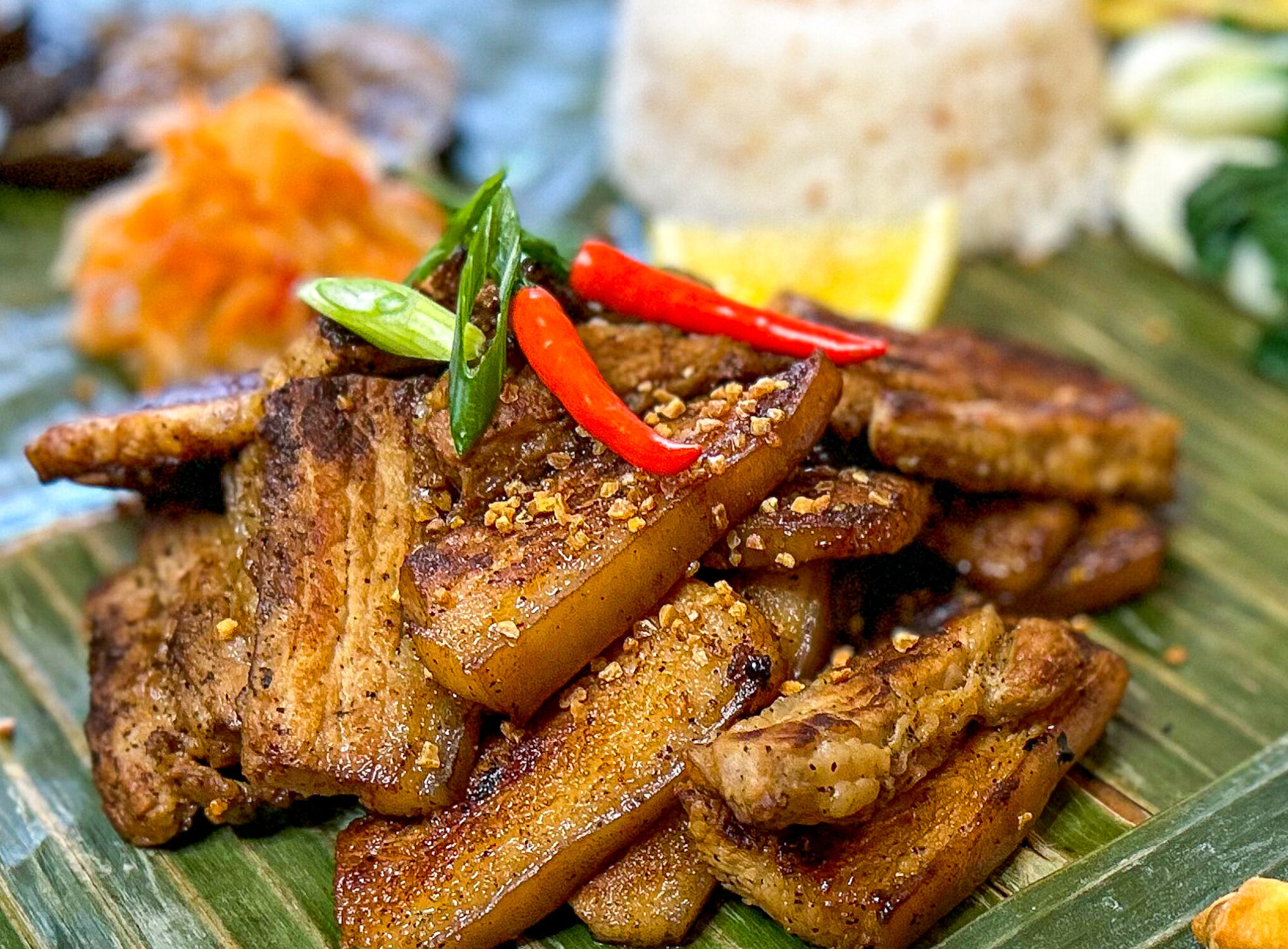
Inihaw na Liempo
BBQ Pork Belly.
A classic sweet and savoury Filipino barbecue with pork belly is typically grilled over charcoal, but can also be conveniently prepared in the oven. The marinade includes soy sauce, lemon or calamansi juice, sugar, and garlic. A sawsawan – one of the dipping sauces you have at your table – is almost mandatory. It’s also recommended to mix-and-match the pork belly pieces with things like the Salted Duck Eggs and Tomatoes or any of the fruit salads. If you’re craving a little spice, try it with the Palapa – just delicious!

Halabos na Hipon
Fried Garlic Shrimp. Filipinos are famous for the many different ways they prepare and cook shrimp. Since we’re doing a beach feast theme the method for this shrimp is very simple: shrimp pan fried in butter with lots (and lots) of garlic. Cooked in the shell, shrimp are much more flavourful. The best way to enjoy these succulent shrimp is to first suck all the delicious pan fried butter and garlic off the shell before you devour the shrimp itself. Really adventurous eaters like to suck the rich flavours from the shrimp head after separating it from the body. And once you’ve separated the head and pulled off the legs, you can almost certainly go ahead and eat the shrimp whole, shell and all. Most people prefer to remove the shell before eating. This will pair beautifully with the sea grapes, mango and papaya salads and all the dipping sauces. Simple and delicious!
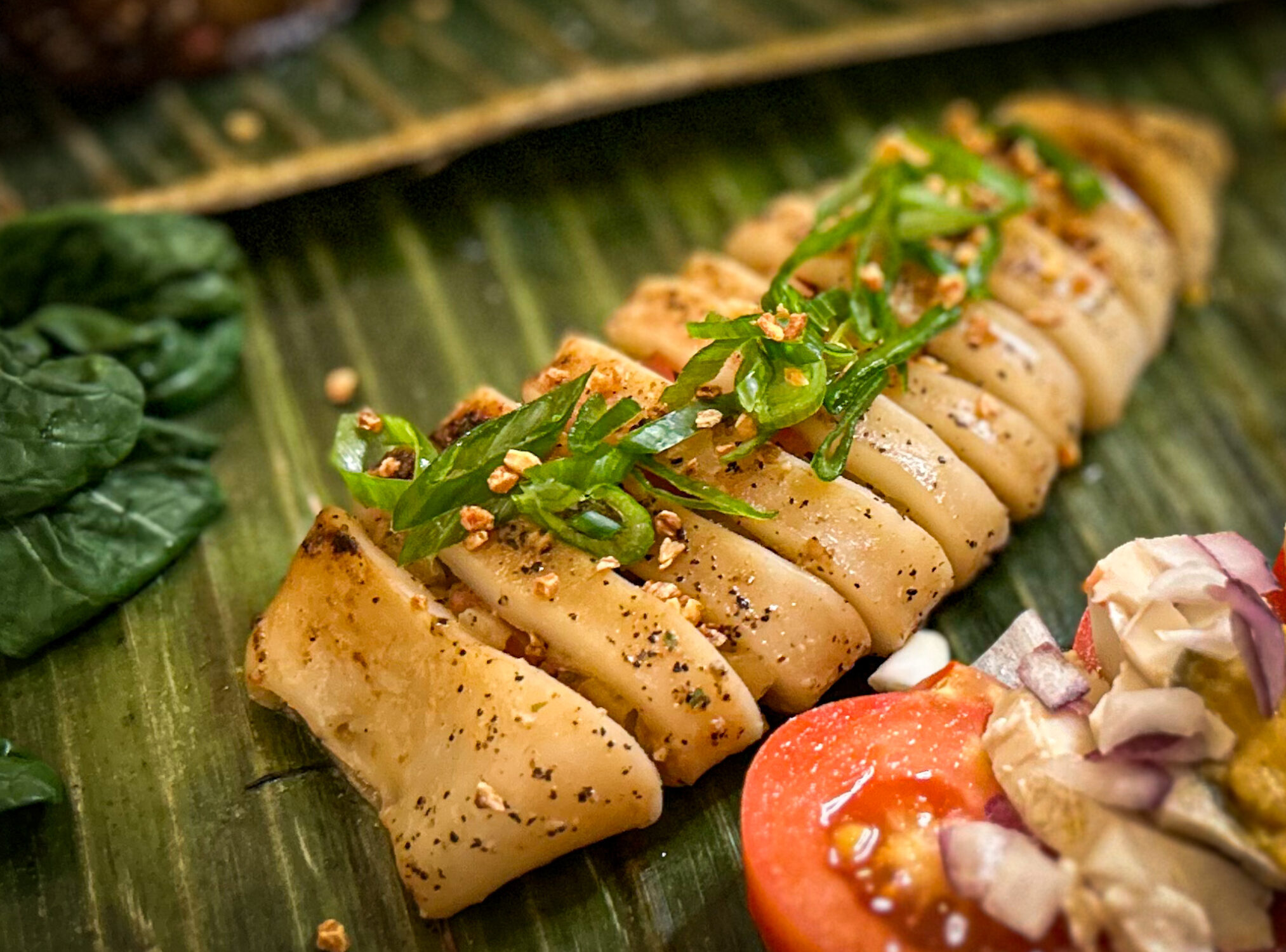
Inihaw Na Pusit
Stuffed grilled squid.
The squid tube is marinated in a sweet and tangy vinaigrette, stuffed with onions and tomatoes, and grilled (indoors on an iron plate or outdoors on a grill). It’s great as a main course, but for our Kamayan experience this squid is wonderful accompanied by salted duck egg, grilled eggplant, or either the mango or papaya salad. Oh, and don’t forget to dip!
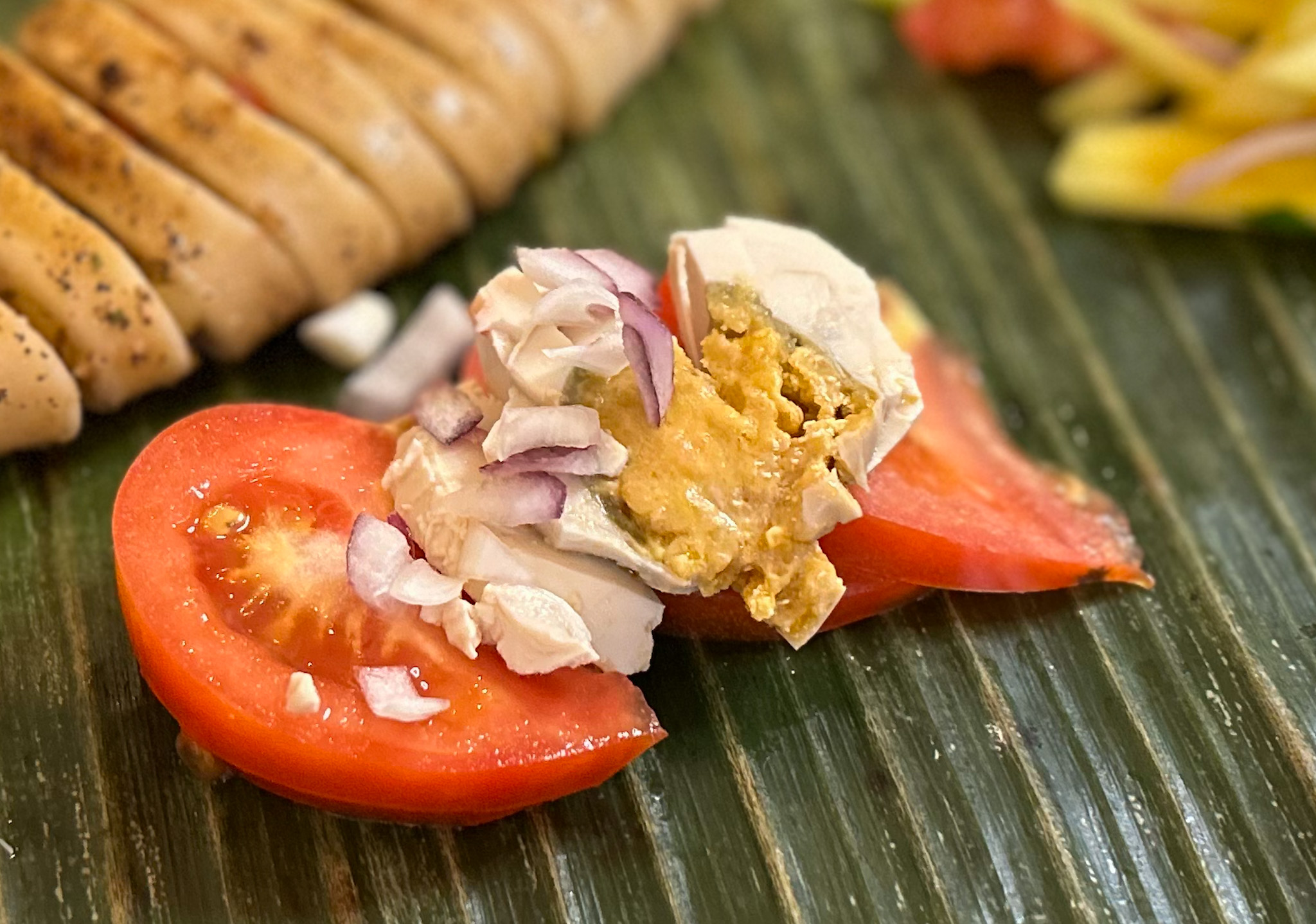
Itlog Na Maalat
Salted Duck Egg on Tomatoes
This concept originated in 6th century China and spread throughout Asia.
Salted duck eggs are made using a brining method that can take many days. The brining solution gradually seeps through the egg shell making the egg white’s softer when boiled and giving them a distinctly salty quality. The yolk, as usual, is the best part of this, deepening in colour and adding more richness to the flavour (yes… it’s possible it can make egg yolk taste even better!) Every Asian culture has their own take on how they include salted duck eggs into their cuisine, and in the Philippines their use predates Spanish colonialism. Modern cooks are even finding ways to incorporate them in sweets and desserts. This is never meant to be eaten alone, but is mixed with other dishes. They pair beautifully with tomatoes and are traditionally served with salted fish. In the spirit of a true Kamayan experience, we encourage you to mix and match them with any of the dishes on your plate.
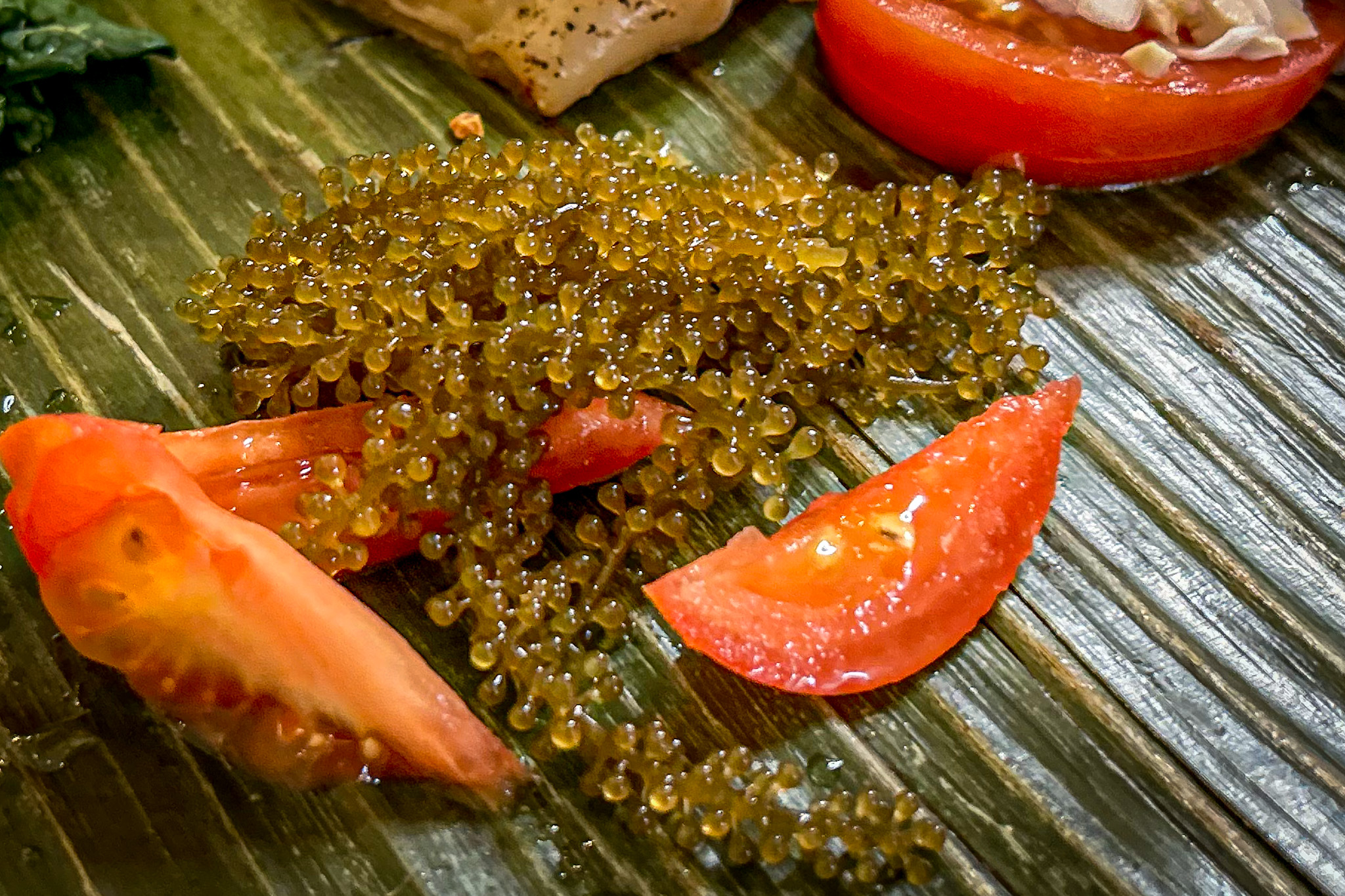
Lato
Sea Grapes.
We are so excited to share this rare dish with you! Rarely seen in Canada, this edible seaweed has been imported specifically for this event. It is known as umi-budō in Japan and is naturally abundant in the Philippines. Sea grapes are an excellent example of how a cuisine reflects a culture’s physical environment. Like so many ocean plants, sea grapes have a briny, salty taste which accents the variety of dipping sauces that they are dipped in at any table. They are also treasured for the popping sensation that occurs in the mouth when they are eaten. And, as is common with so many other ocean plants, they are rich in calcium and potassium; they are even purportedly effective at lowering blood pressure. Enjoy them on their own with dipping sauce, or mix and match them with other ingredients on the table.
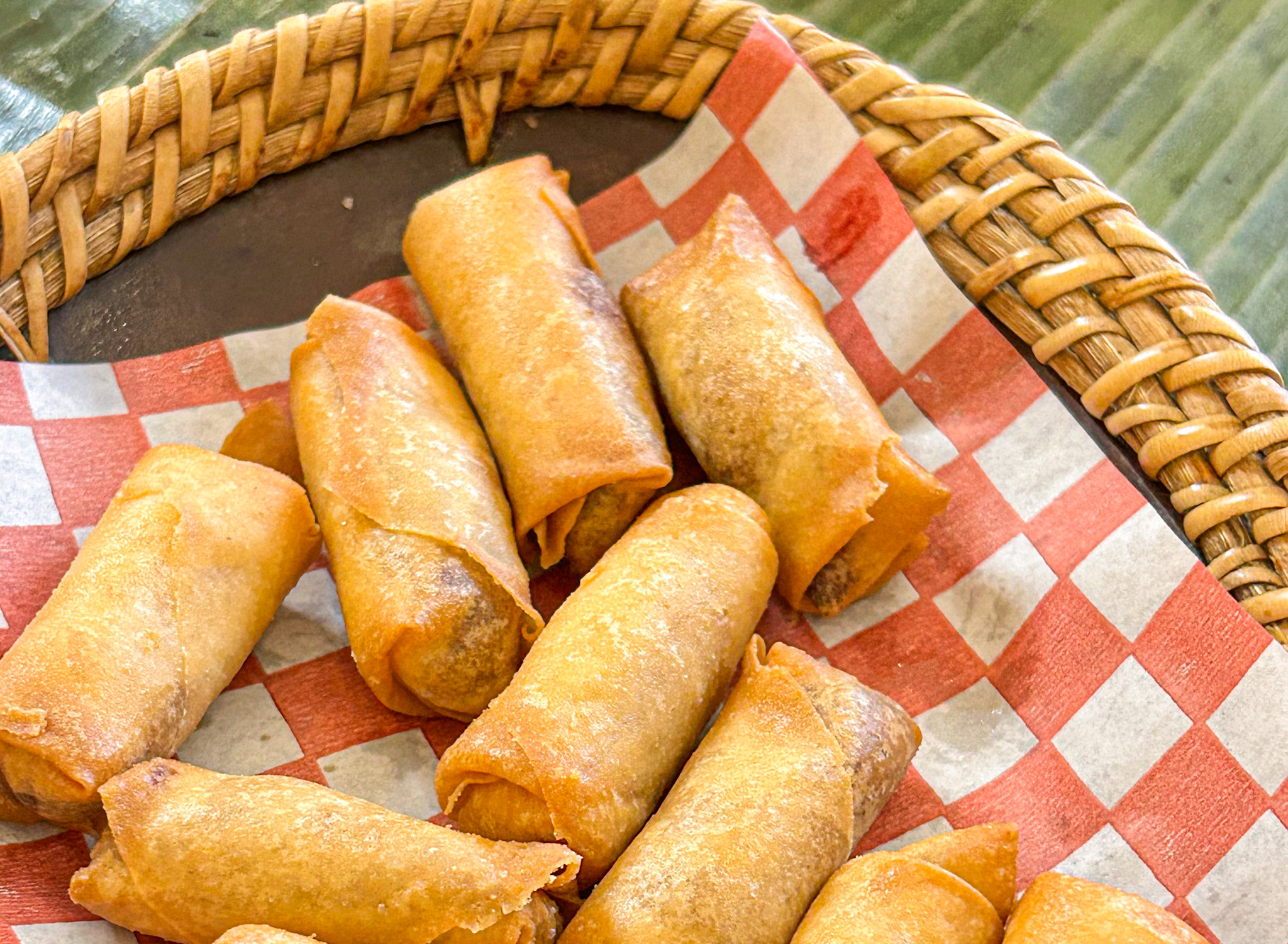
Lumpia Shanghai
Pork Spring Rolls
Despite the dishes name, these rolls originate from Spanish influence, originally being made with tortilla. Starting as a Filipino version of Taquito (deep fried taco), Chinese immigrants changed the wrapping to one made using rice flour and hence adopting the Chinese name. These are filled with ground pork sautéed with garlic, onions, shallots and spices.
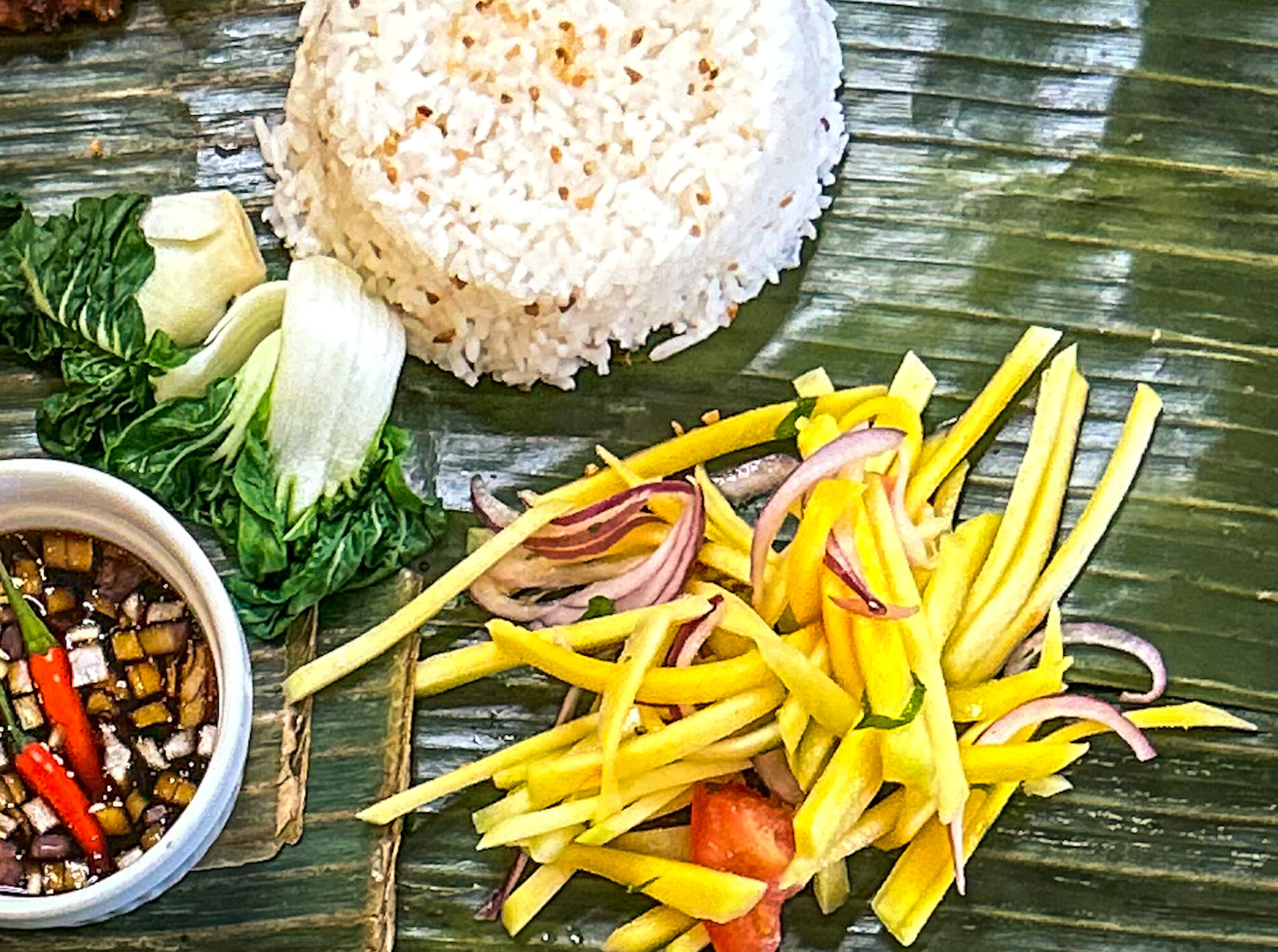
Ensaladang Mangga
Mango Salad
Commonly made with diced tomatoes and onions, this Filipino version of unripe mango salad gets its unique flavour from shrimp paste (bagoong alamang) and calamansi which combined make the dressing.
It’s typically meant to be paired with other foods, and is particularly well matched with dried or grilled fish, and with roasted or grilled pork.
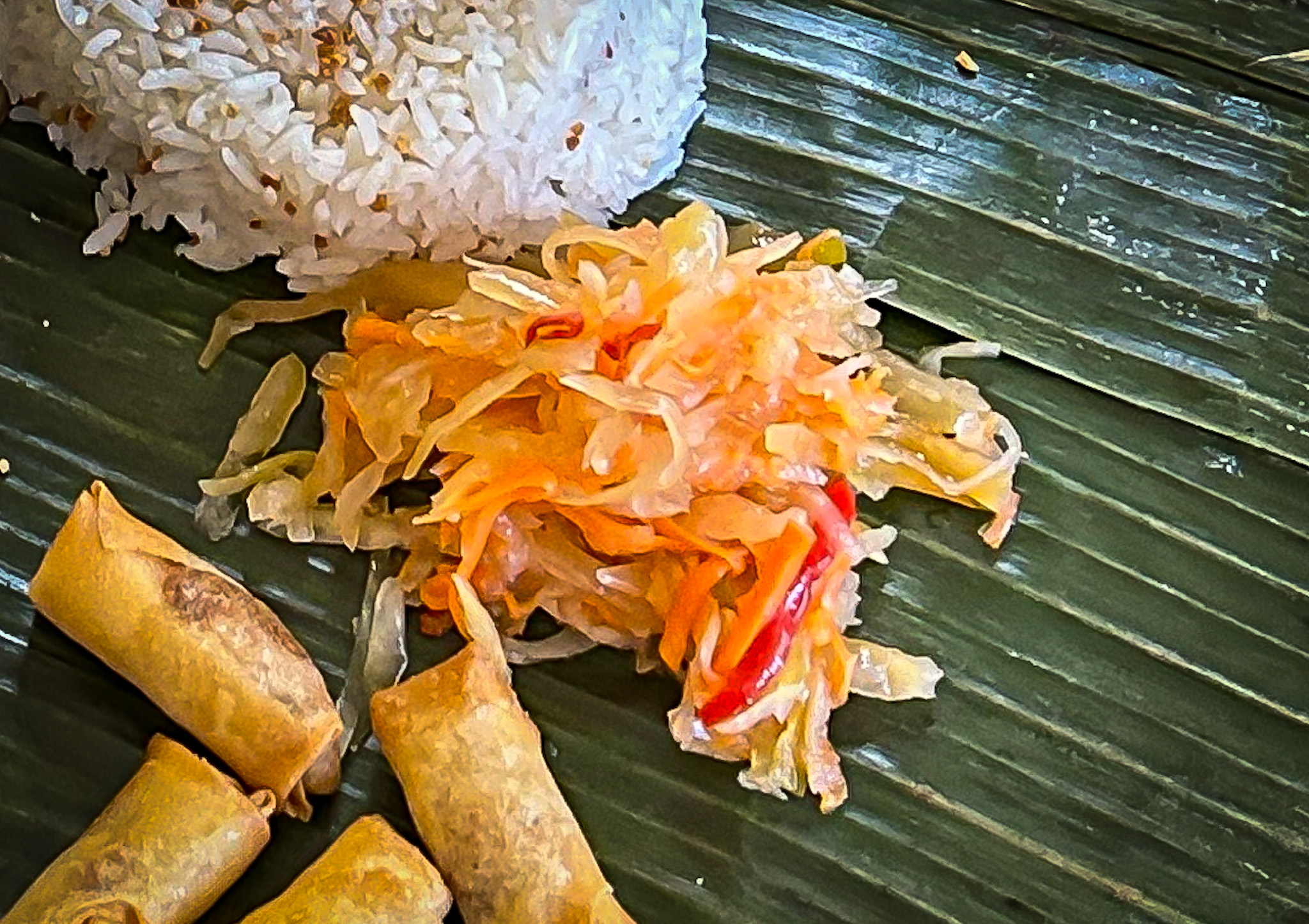
Atchara
Papaya Salad
This is a traditional condiment of pickled green papaya, carrots and peppers in Filipino cuisine. Crunchy green papaya, combined with the sweet-sour tang of the gingered pickle juice, makes for an incredibly refreshing accent to so many dishes.
Palapa
Hot Sauce
Palapa is a sweet and spicy Filipino condiment consisting of thinly chopped white scallions, pounded ginger, turmeric, labuyo chili, and toasted grated coconut. It originates from the Maranao people of Lanao del Sur. The ingredients are mixed together and cooked briefly or cooked until somewhat dry. This is an absolutely delicious sauce and it pairs beautifully many of the dishes on this menu.
Sinangag
Garlic Rice
Because rice is life! No Filipino feast is complete without some perfectly cooked rice.
Assorted Grilled Seasonal Vegetables
Posted by ai.reena


